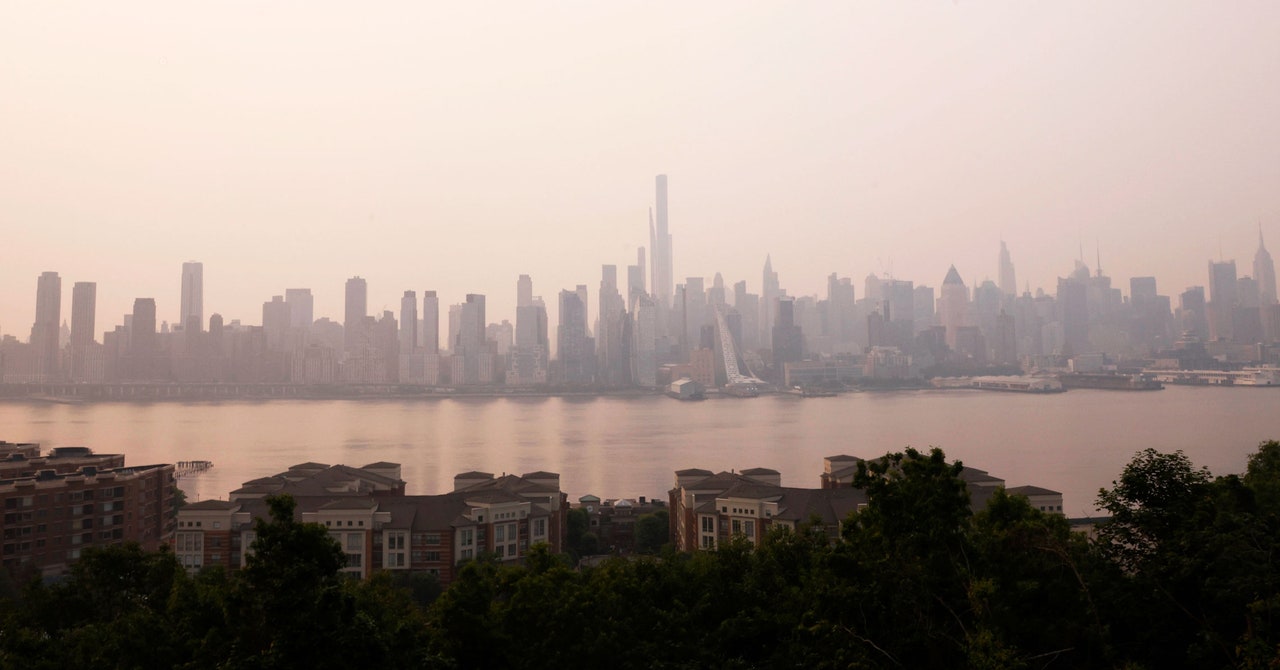
Smoke from wildfires in Canada has engulfed the East Coast, cloaking cities in a hazy smog and putting some 100 million people under air quality alerts. More than 400 fires are burning in British Columbia, Alberta, Quebec, and Ontario, and half are uncontrolled. New York City became home to the worst air quality in the world. Philadelphia has also issued a code red alert, advising people to stay indoors, and the plumes may continue inundating the region for several more days to come, with the smoke stretching through Washington, DC and down to Atlanta, Georgia.
In the United States, supercharged wildfires once seemed like a uniquely West Coast problem, like the 2018 Camp Fire which obliterated the California town of Paradise. A range of factors contributed to that massive blaze, including the region’s legacy of fire suppression, which allowed dead brush to pile up. Climate change means hotter temperatures dry that brush out, so it burns catastrophically. That’s also the problem in Canada right now. The number of fires for this time of year has only increased slightly above the average, but “the size of the fires and the intensity of fires has significantly increased,” says Mike Flannigan, a professor of wildland fire at Thompson Rivers University in British Columbia.
In other words: East Coast, welcome to the Pyrocene, or the Age of Flames, as fire historian Stephen Pyne calls it. Climate change and human meddling in the landscape have combined to make wildfires bigger and more intense, big enough to send clouds of toxic smoke not only from Canada to the East Coast, but across whole continents. “Climate change is acting as a performance enhancer: It’s exacerbating what is a natural rhythm,” says Pyne. “There’s no reason to think that those trends will suddenly stop.”
“It’s a global problem now,” says Mary Prunicki, director of air pollution and health research at Stanford University’s Sean N. Parker Center for Allergy Research. The immediate health effects of exposure to wildfire smoke can be devastating for vulnerable people, but less is known about long-term effects from short exposure. “This is relatively new, to have this type of massive exposure to a group that’s never been exposed before,” she says.
Wildfire smoke is a complex amalgamation of materials, including burnt plant material and—if buildings go up in flames—human-made stuff like plastic. What makes smoke visible are its toxic particulates—dubbed PM 2.5 and 10, meaning particles smaller than 2.5 and 10 microns. But there are a lot of invisible nasties in there too, like benzene, formaldehyde, carbon gasses and even fungal pathogens. As the smoke travels through the atmosphere, it can actually form new chemical hazards over time, like ozone, which exacerbates asthma. “The biggest health impacts are definitely from the particulate matter,” says Rebecca Hornbrook, an atmospheric chemist at the National Center for Atmospheric Research, who has flown planes through wildfire smoke to study its components. “But there are a lot of things that are omitted that are on the EPA’s list of dangerous chemicals.”
Wildfire smoke can cause immediate health effects, like heart attacks, stroke, and bronchitis, particularly in more vulnerable people with respiratory issues, and can be threatening to pregnant women. “These single exposure events can be really devastating to people with preexisting conditions,” says Shahir Masri, an air pollution scientist at the University of California, Irvine.
Exposure to this kind of pollution can also weaken the immune system. A 2021 study found that Covid-19 cases and deaths in California, Oregon, and Washington the previous year were exacerbated by increases in fine particulate air pollution from wildfire smoke. “Whether it’s Covid or any other virus, this is a time to avoid not only exposure to fine outdoor matter, but also really trying not to get sick,” says Francesca Dominici, a professor of biostatistics, population, and data science at the Harvard T.H. Chan School of Public Health who worked on the study. “Your ability to fight the virus is less effective.”
This year’s fire season in Canada is “unprecedented” and may become record-breaking, says Flannigan. Hundreds of fires have been burning in Canada—some for days or weeks—usually started by human activity or lightning, then fed by dry vegetation, and worsened by hot, dry, windy weather. Rising warm air on land has lofted that smoke to between 5,000 feet and 20,000 feet high, where the haze gets rapidly transported south and east in strong winds.






